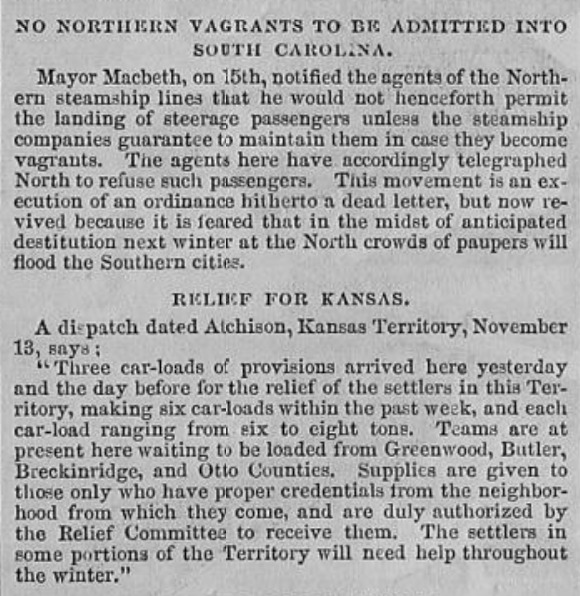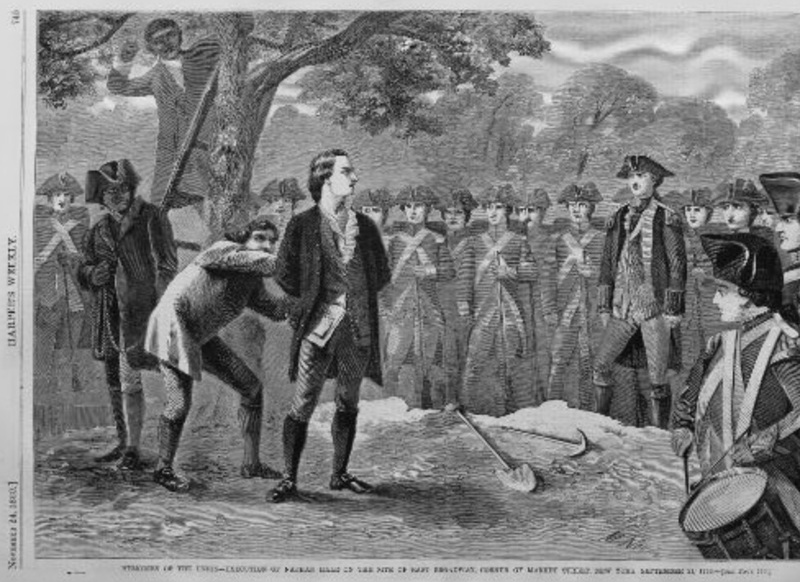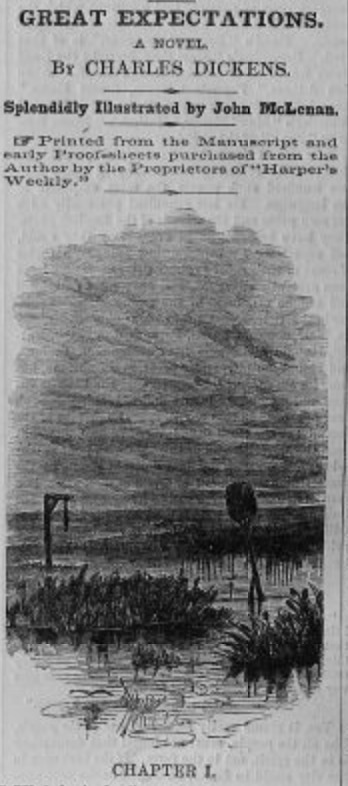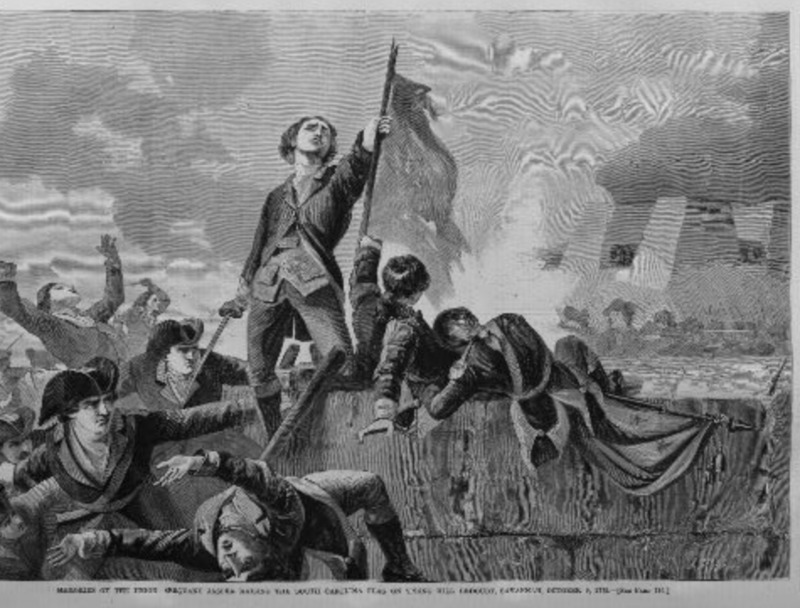Part 1
Introduction
In the first two chapters of Great Expectations we are introduced to not only the main character Pip but an escaped convict who threatens Pip into getting food and a file for him. This is interesting in comparison with the other works published in Harper’s Weekly. The American magazine is publishing Dicken’s novel during the American Civil War. Because of this historical event much of the material surrounding the chapters deals with the coming conflict. The political debates around the issue of slavery had turned to talk of invasion and physical violence (Varon). This setting of conflict must have affected American readers as they could see the fear of crime and violence played out in the meeting of Pip and the escaped convict. The American Civil War was a conflict that was brewing for years as Varon notes in her book Disunion!:the Coming of the American Civil War, 1789-1859. In one chapter Varon discusses the debate around slavery in Kansas in 1858 only two years before the first chapters of Great Expecations are published in Harper’s Weekly. The debate between the two sides of the slavery problem was beginning to ramp up and the rhetoric was becoming more and more focused on violence and domination. As Varon notes when talk of armies began it was not a “metaphorical army, of editors and ministers and politicians and novelists, but “an army of soldiers-men brought up on horseback, with guns in their hands.”’ (309). It is clear that the threat of violence was around for many years and I argue that this overhanging danger influenced what was published in Harper’s Weekly and also made the references to violence and danger in Great Expectations more salient for American readers.

Domestic Intelligence: South Carolina, Kansas
Found after the first three chapters of Great Expectations is a list of domestic news. There are mentions of Lincoln running for president and pictured above, a note that South Carolina is cracking down on vagrants. The title is “No Northern Vagrants to Be Admitted into South Carolina” and the paragraph explains no northern boats would be allowed to dock unless they could guarantee that passengers and employees would not become vagrants. This very strong stance against vagrants shows the division of the country at the time since it is “northern vagrants” they are keeping out as well as a fear of poverty and the crime usually thought to come with it. It is interesting that these news articles follow the chapters of Great Expectations in which Pip first encounters Magwitch. In a way, Magwitch could be seen to embody the fears that promote this sort of rulemaking. Magwitch is someone who has entered this area, is a criminal and is now forcing resources out of a family that cannot afford to lose them. Magwitch is described as “a fearful man, all in coarse grey…with no hat, and with broken shoes.” (Dickens 40) as description that could also be used to describe someone in a state of poverty. The South Carolina report is followed by one for Kansas stating that relief supplies will only be given to those who have proper credentials to prove they are from the neighbourhood. Again, this is an interesting contrast with Magwitch’s use of threats to get food. For readers, this could tie into the growing concerns around supplies and division and violence that come with the Civil War. Magwitch could represent to readers what they might experience from a war.

Memories of the Union - Execution of Nathan Hale on the site of East Broadway, corner of Market Street, New York, September 21, 1776
This is an illustration depicting an event from the American War of Independence. The scene is the execution of Nathan Hale, a spy for the British. It is a reminder of a past war while the threat of war hangs over the country again. This may affect the reading of Great Expectations like the other images and news stories in that it reminds readers of real crimes and violence that have occurred in the past. Seeing a scene where a criminal is about to be executed would make the situation that Magwitch is in stand out. The possible violence that Magwitch could experience as an escaped convict would be in their minds and this image provides a visual example. Also, this image of a spy from the War of Independence would also remind readers of the threats that war presents. The Civil War being a time of conflict and division where people in the same country are on different sides of the war can cause fear and suspicion. The threat of a spy would heighten that fear as it is a threat that is within your own neighbourhood. This is similar to the fear that Pip fears as he is threatened in his neighbourhood and his fears follow him into his own house. Pip describes his feelings that night “I was in mortal terror of the young man who wanted my heart and liver; I was in mortal terror of my interlocutor with the ironed leg; I was in mortal terror of myself, from whom and awful promise had been exacted.” (Dickens 51). His home has been transformed into a place where he is in danger from the outside world. A distant outside threat has intruded into Pip’s domestic sphere and an image of a spy being executed could remind readers that these threats occur outside of literature and with war looming they should be taken into account.

Chapter 1 Beginning Illustration
The beginning of Chapter One in Harper’s Weekly is an illustration of the marshes where young Pip lives. This image seems dark and desolate and a wooden structure in the background seems to have a noose like length of rope hanging from it. This image sets an unnerving scene which is reinforced with the chapter opening in a cemetery. This grim nature continues as Pip contemplates the graves of his parents and siblings and is ambushed by the escaped convict Magwitch. For readers of Harper’s Weekly this image may resonate with them in that the Civil War is starting to brew. The fear and threat of violence is hanging over the country and a depiction of a noose followed by an encounter with a criminal in a cemetery could have a greater effect on American readers as they are surrounded by stirrings of violence. Varon relates how the language of both sides of the conflict began to use language around invasion and war. The idea that violence could happen in your own neighbourhood most have been part of people’s lives at that time. Much of the content following the chapters of Great Expectations relates to war, violence or fear. So, this context could put the danger that Pip could face at the hands of an unknown convict into sharper focus. News of violence and crime could also make the fate of Magwitch more palpable as ideas of violence and execution would be more common.

Memories of the Union - Sergeant Jasper raising the South Carolina flag on Spring Hill Redoubt, Savannah, October 9, 1779
This is another image depicting a scene from the American War of Independence. The two images were printed side by side. Again, this image works to remind readers of the past wars that happened in America. This one seems to present a more heroic image of a man raising a flag but there is still the impression of violence and conflict. There are canons in the background, armed men and people falling as if they are injured. These images must have stirred fear in the people reading Harper’s Weekly as the Civil War is coming and acted as a reminder of the violence that war brings. This must also have added to the effect of the threats of violence that Magwitch makes to Pip. This would have been made worse by the fear that the civil conflict was stirring up.

Chapter 1 Illustration "You young dog!"
There are several illustrations in Harper’s Weekly publication of the first chapters of Great Expectations. The one pictured above features Magwitch and Pip in the cemetery. Important here is the way that Magwitch is presented. He is dressed in tattered and ragged clothes; his beard is unkempt and his unruly hair is held back with a bandana. This image seems to draw a connection with the Domestic News story that expresses concern about vagrants. Magwitch certainly looks dishevelled as might be expected of a vagrant, the manacles though give away his status as a criminal. This depiction gives a visual representation of the fears that seem to be presented in the other works in this volume of Harper’s Weekly. This image also captures a moment of unsettling violence. The caption is quoting Magwitch who is noting the fatness of Pip’s cheeks the conversation continues ““Darn Me if I couldn’t eat ‘em,” said the man, with a threating shake of his head, “and if I han’t half a mind to’t!”” (Dickens 41). This is a terrifying threat and Magwtich uses this fear to get food and tools out of Pip. This must have been a more unsettling moment for American readers as the danger of war was permeating their lives even in their magazines and stories.
Conclusion
The opening chapters of Great Expecations are filled with threats of violence and fear as Pip meets the escaped convict Magwitch. At the time of publication in American the concerns around the issues of slavery are growing and as Varon notes the rhetoric has begun to turn to actual threats of war and invasion. The fear of war and reminders of the violence and dangers that accompany war are seen throughout Harper’s Weekly. The inclusion of a dangerous convict that has entered the protagonist’s neighbourhood must have elicited some fear from the American readers especially since this would also act as a reminder that a war was about to be fought in their own neighbourhoods. This collection aims to show how the fear in the political debates showed itself in other areas of American life and would have affected the reading of violence in the opening chapters of Great Expectations.
Works Cited
Dickens, Charles. Great Expectations, edited by Graham Law and Adrian J. Pinnington,
Broadview Press, 1998.
Dickens, Charles. "Great Expectations: Chapter I-II." Harper's Weekly, vol. 4, no. 204. 24 Nov
1860. pp 740-742. Internet Archive. https://ezproxy.lib.ucalgary.ca/login?url=https://search.ebscohost.com/login.aspx?direct=true&db=h9k&AN=66772760&site=ehost-live&kw=true&acc=false&lpId=divl23&ppId=divp4&twPV=&xOff=285&yOff=1369&zm=3&fs=&rot=0&docMapOpen=true&pageMapOpen=true
"Domestic Intelligence." Harper's Weekly, 24 November 1860, p. 743.
https://ezproxy.lib.ucalgary.ca/login?url=https://search.ebscohost.com/login.aspx?direct=true&db=h9k&AN=66772760&site=ehost-live&kw=true&acc=false&lpId=NA&ppId=divp6&twPV=true&xOff=5&yOff=112&zm=1&fs=&rot=0&docMapOpen=true&pageMapOpen=true
"Memories of the Union - Execution of Nathan Hale on the site of East Broadway, corner of
Market Street, New York, September 21, 1776." Harper's Weekly, vol. 4, no. 204. 24 Nov 1860. p. 745. Internet Archive. https://ezproxy.lib.ucalgary.ca/login?url=https://search.ebscohost.com/login.aspx?direct=true&db=h9k&AN=66772760&site=ehost-live&kw=true&acc=false&lpId=divl23&ppId=divp9&twPV=&xOff=83&yOff=180&zm=2&fs=&rot=270&docMapOpen=true&pageMapOpen=true
"Memories of the Union - Sergeant Jasper raising the South Carolina flag on Spring Hill
Redoubt, Savannah, October 9, 1779." Harper's Weekly, vol. 4, no. 204. 11 Nov 1860, p. 744. Internet Archive. https://ezproxy.lib.ucalgary.ca/login?url=https://search.ebscohost.com/login.aspx?direct=true&db=h9k&AN=66772760&site=ehost-live&kw=true&acc=false&lpId=divl23&ppId=divp8&twPV=&xOff=0&yOff=0&zm=1&fs=&rot=90&docMapOpen=true&pageMapOpen=true
Varon, Elizabeth R.. “War to the Knife: Images of the Coming Fight” Disunion!: The Coming of
the American Civil War, 1789-1859. University of North Carolina Press, 2008, pp. 305-335.